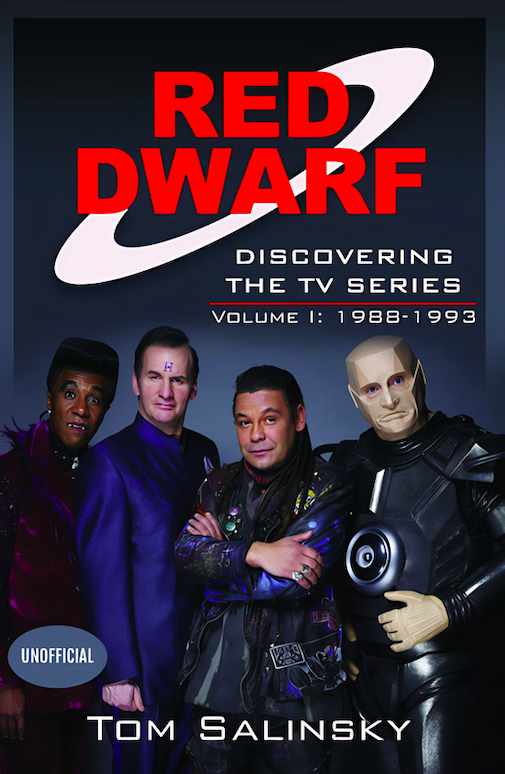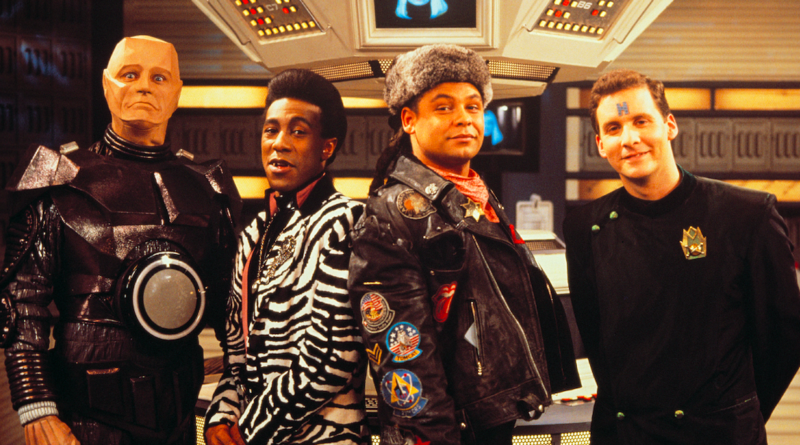INTERVIEW: Rediscovering the influential TV series ‘Red Dwarf’
Photo: Red Dwarf, the successful British TV series, is celebrated in a new unofficial book by Tom Salinsky. Photo courtesy of Pen & Sword Books / Provided by Gingerbread Agency with permission.
Tom Salinksy has penned a love letter to the influential sci-fi series Red Dwarf. In fact, his love letter to the TV show is so long that it will be split into multiple volumes. Fans can now read his unofficial first entry, titled Red Dwarf: Discovering the TV Series: Volume I: 1988-1993.
The landmark comedy show, which is equal parts Star Trek and The Hitchhiker’s Guide to the Galaxy, has been an ongoing hit for 12 seasons, with more episodes hoped for in the future. This little-show-that-could continues to impress critics and fans alike, nearly 40 years after its initial launch.
Salinksy, who co-wrote The Improv Handbook, recently exchanged emails with Hollywood Soapbox to talk all things Red Dwarf. This type of “Discovering” book is well within his wheelhouse; he’s also the author of Star Trek: Discovering the Television Series. Questions and answers have been slightly edited for style.
When did you first fall in love with Red Dwarf?
I was there at the very beginning. As an existing fan of The Young Ones, Doctor Who, The Hitchhiker’s Guide to the Galaxy, this show could have been tailor-made for me. Weirdly, for a series which is notable in part for how obscure the cast was, what made it pop out of the listings magazine for me was faces I already knew from other shows, as much as anything. “Proper” actors Alfred Molina and Alan Rickman were both in contention, but it didn’t work out. And so they ended up with an impressionist, a dancer, a performance poet and a stand-up comedian instead. But I knew Craig Charles and Norman Lovett from Channel 4’s Saturday Live and Chris Barrie from ITV’s Spitting Image. A new comedy show, set in space, with those three in it? Yes please.
What do you find so fascinating about the show? Why has it been such a success?
It’s remarkably long-lived, both in terms of number of episodes and years it has been on the air. The total of 74 episodes ranges from a slender 25 minutes on digital channel Dave, to a 90-minute special which is currently the last ride of the boys from the Dwarf. That doesn’t sound like many, not compared to popular network shows in the USA, which pump out 20-30 episodes a year, but in the UK only a handful of sitcoms have produced more episodes and countless well-loved series have produced way less. To still be making more episodes (if the rumours are to be believed) 36 years after the first season aired is almost unprecedented — and to be still doing it with the same cast is astonishing.
Now, this is a symptom of its success, not a cause. Writers Rob Grant and Doug Naylor managed to get it on the air at a time when television science fiction was hard to come by. Even in America, Paramount couldn’t find a network that would take Star Trek: The Next Generation and was forced to stitch together a virtual network by doing dozens of individual syndication deals. The BBC was desperately trying to rid itself of Doctor Who (and succeeded around the time of Red Dwarf’s third season); Star Cops had been and gone. Tripods was axed after two of its planned three seasons. So, whether TV bosses believed it or not, there was an audience there that was hungry for this kind of content.
But, those TV bosses were right that their £150,000-an-episode shows, shot on videotape in front of an audience, couldn’t compete in terms of spectacle with Aliens, Blade Runner or Star Wars. So early on, Rob and Doug put most of the emphasis on the characters, and the dynamic of likeable loser David Lister and hateful loser Arnold Rimmer is the core of the show, much more than the plot details involving Lister being the last living human and Rimmer being a hologram.
How do you structure your book?
For every season, there’s a complete behind-the-scenes account of how the shows got made. There are lots of amazing stories of how this team worked miracles with limited resources. Then I give you a critical account of each episode, with a star rating from 1-5. Any Red Dwarf is better than most things which aren’t Red Dwarf, but there’s no point having a five-star rating if you only use the top end. So I do give my least favourite episodes low scores and try to explain why. When this show is on song, though, it’s incredibly hard to beat. Lastly, for each episode I’ll check off some fun things like the bits where Rimmer’s a bit more solid than he should be, all the bits familiar from other sources, a best gag, a worst special effect and so on. And then, because the manuscript was rather longer than the publishers were expecting, you have the first six seasons in Volume I and the remainder in Volume II, out next year.
How long did it take for you to watch and analyze the entire show’s history?
I started in July 2022 and delivered the manuscript in May 2023. This did involve watching several episodes multiple times, not least the very first episode where I watched the transmitted version, the transmitted version with cast commentary, the transmitted version with commentary from Doug Naylor and director Ed Bye, the remastered version, the remastered version with commentary from Ed Bye and colleagues, the first edit, the first edit with commentary from Rob and Doug, and the YouTube lockdown commentary with Rob, Ed Bye and producer Paul Jackson. You could probably read the whole book in the time that took me. The same material is also covered in comic strip form and in the first Red Dwarf novel. A Japanese dub is included on one of the DVD releases, but I didn’t think I would benefit greatly from watching that as well.
Are you excited for new episodes in 2025?
If the rumours are true, it’s thrilling. But despite clear evidence, not least from the cast’s social media, that the intention is there, we have yet to hear anything official. Of course, more Red Dwarf means that my pair of books won’t remain definitive, but that’s only good news as far as I’m concerned.
Why do you think the show hasn’t had similar success in the United States, or am I mistaken?
An attempt was made to do an American version, but it didn’t get beyond the pilot stage. You can read the whole saga in Volume II of my book. It’s easy to think that because 14 episodes of the U.K. version of The Office became a 200-episode, multi-Emmy winning international success story that American TV is awash with successful remakes of British shows, but actually The Office is an outlier. Remakes of UK classics like Fawlty Towers, Dad’s Army, Absolutely Fabulous and The Vicar of Dibley have tended to crash and burn — along with U.K. remakes of U.S. shows like The Golden Girls, Married with Children or That ’70s Show.
Where The Office succeeded was in teasing out the universal themes of the U.K. show (the world’s worst boss who thinks he’s the world’s best boss, the unrequited office romance, the grind of office life), creating a richer cast of supporting characters and — crucially — giving Michael Scott a win here and there. Like Arnold Rimmer, Ricky Gervais’s David Brent is a born loser who can’t succeed at anything. But despite having many of the same failings, Michael Scott is a decent salesman and is allowed to win sometimes. The tragedy of David Brent plays out completely over 14 faultless episodes. The comedy of Michael Scott has many more ups-and-downs and sustains for longer.
The Red Dwarf remake fell into the traps of slavishly copying the things that don’t really matter and ignoring or not prioritising the things that drove the show forward. But the U.K. show has a cult following among American fans, for whom some of the references must require frequent Googling — I can’t imagine many casual viewers being familiar with Berni Inn, Pot Noodles, Vimto or Pussycat Willum. Still, maybe that’s the appeal?
By John Soltes / Publisher / John@HollywoodSoapbox.com
Red Dwarf: Discovering the TV Series: Volume I: 1988-1993 by Tom Salinsky is now available. Click here for more information.



